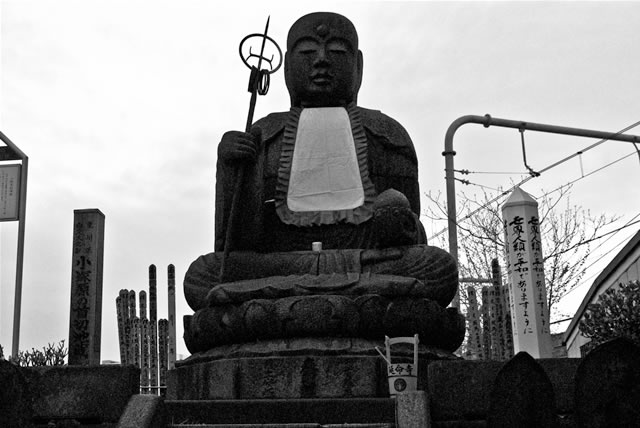
Like Daruma he also comes from the Buddhist universe. But Jizo Bosatsu (地蔵菩薩) or more simply O-Jizo-sama (お地蔵様) is much closer to the Western concept of a “saint”; allegedly he once existed as a real person (a young woman who used every exertion to save her mother from hell) but with the passage of the centuries changed sex, attained a super-human status and was integrated in all Asian cultures as a guardian of children that died before their parents (and particularly of stillborn or aborted children) as an aid for those who try to cross the Sanzu no Kawa (三途の川) river that leads to the other world and as a protector of travelers. This last capacity of his, is symbolized in the stone statues that are called “dosojin” (道祖神) and can be found in roadsides all over Japan –even there, though, the statue will be wearing a red hood or a red bib, dedicated by some mother moaning for a child that left early.
One of the bigger Jizo-sama in Tokyo can be found in the Minami Senju area of the Arikwawa ward, in the eastern part of the city. The temple (and the cemetery) hosting him is hidden between the elevated train lines and they are very hard to find if you don’t know where to look but if you happen to be there, especially when the sun is setting, the sensation emitted by the blackened from time huge statue with the sakujo (錫杖) stick in his hand (to warn the insects he is approaching, so he won’t harm them by accident) is absolutely eerie. And rightfully so since this spot was Kozukappara (小塚原) one of Edo’s execution grounds and this Jizo, called “Kubikiri Jizo” (首切地蔵) or “beheading Jizo” was there to offer executed people the last service they would need: an, as uneventful as possible passage to the invisible world.
The stories surrounding Jizo are almost exclusively heavy; almost macabre. But in the Japanese consciousness his image doesn’t evoke so much the idea of death as the idea of assistance and mercy; even though another Buddhist deity, Kannon (観音) is considered the personification of compassion, Jizo-sama is much more human and much closer to everyday life, even for people who have no relationship to Buddhism (if such people indeed exist in Japan). Perhaps because since the time he was still called Ksitigarbha and lived in India he used to be portrayed in a very child-like way (a tradition generally still followed in Japan) which makes us remember the time we ourselves were children or the need our children have for protection. Or perhaps because we all more or less feel as travelers –in space or time- and we feel a need for someone to watch over us.
Grigoris A. Miliaresis is a journalist and translator. He has worked for many newspapers, magazines and publishing houses and specializes in the Internet, the martial arts and Japan where he has been living for the last few years.